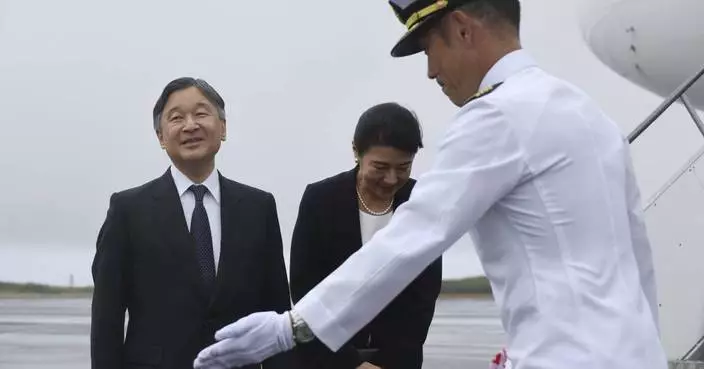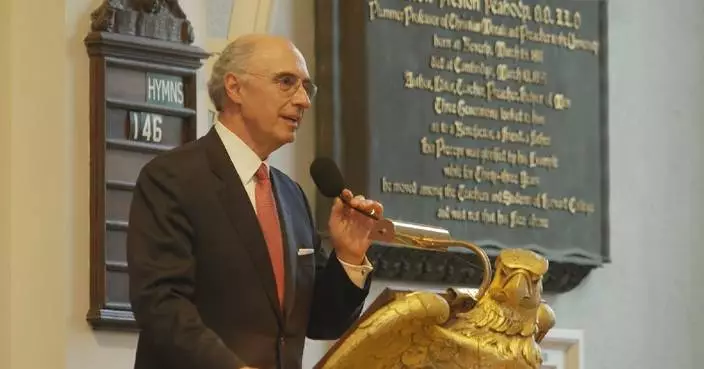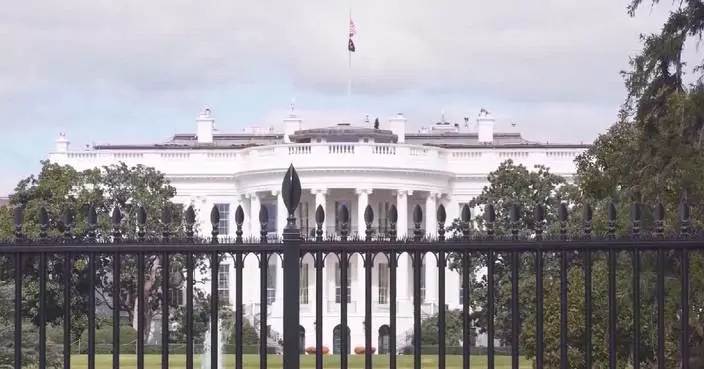ATLANTA (AP) — Black women around the world gather in salons, dorm rooms and living rooms for hours at a time to get synthetic braids put in their hair. But they're wondering if the convenience and fashion benefits are being outweighed by potential health hazards.
The question circulating on social media and in the Black community follows on the heels of a proposed federal rule — that's still in limbo after multiple delays — to ban the carcinogen formaldehyde in hair-straightening chemicals.
There's a thin body of research into the potential issues of using synthetic hair for braids. The latest addition is an independent study from Consumer Reports into chemicals found in braiding products. Some say the findings are concerning, but others are hesitant to make recommendations in part because the methodology did not go through a typical study review process.
All of the experts who spoke with The Associated Press did agree more research is needed into synthetic braids and other products Black women often use in or on their hair. Here's a look at what's known, what's not known and what you might want to do in the meantime.
Experts say it's difficult to draw conclusions from prior studies. The Consumer Reports study, which was published in late February, said there were dangerous chemicals like lead, benzene and other carcinogens in 10 of the most popular synthetic braiding products.
While experts said the presence of the chemicals is concerning and confusing, they noted the study didn't go through the rigorous scrutiny that it takes to get published in a peer-reviewed science or medical journal.
Javon Ford, a cosmetic chemist who talks about his work on social media, questioned the report's findings, saying "the data set is so limited.” Consumer Reports only sampled two of each product, despite thousands on the market.
James Rogers, the head of product safety at Consumer Reports who led the study, said his hope was to get the information out there because of the lack of research. He noted that it was a pilot project, but that “we thought the results were important enough to start the conversation.”
Research published in 2020 in the journal Environmental Health Insights showed synthetic hair let off volatile organic compounds — chemicals that can easily evaporate into the air — when heated. Synthetic hair is sealed when braided, either by burning it or dipping it in hot water. That study detected many of the same chemicals named in the Consumer Reports study, like the known carcinogen benzene.
Experts can't answer whether the products are truly safe — but that's because there's so little research out there.
There's also little government oversight on the products, which leaves manufacturers to ensure that they're safe. Consumer Reports is petitioning the Food and Drug Administration to begin regulating synthetic braiding hair.
Jasmine McDonald, a professor of epidemiology at Columbia University who has studied the health impacts of chemical hair straighteners, said the Consumer Reports study shouldn’t invoke fear but awareness about the potential harms of braiding hair, the lack of federal regulations and the minimal research.
“I think that in our culture, we sometimes normalize things to the point where we don’t see the harm ... the more that we can raise awareness that some of these cultural routines could potentially provide harm is us having the potential to stop that harm," McDonald said.
If you're concerned about using synthetic braiding hair or straightening chemicals, there are other hairstyles to try.
You can use Brazilian wool hair instead of synthetic hair, said Gloria Okpurukre, who owns Anointed Fingers braiding salon in Fayetteville, Georgia. You can also braid your real hair, but don't expect the same results.
“The purpose of adding the hair is for volume and length,” Okpurukre said. “A lot of people, their hair starts thinning out and they need to add something to make it look nice.”
Some synthetic brands use banana fiber to create the hair, which companies say are less irritating to the scalp. But Ford said you won't necessarily avoid chemicals just because you switch brands.
Raven Baxter, a molecular biologist who has talked about braiding hair on social media, opted to stop using synthetic braiding products because of the lack of information — both on the packaging or in research studies. Now, she uses single-ingredient products in her hair care routine, like aloe vera gel and vegetable glycerin.
“A lot of the work that scientists do, we’re able to do it because a funder deemed it as important to support that research," she said, adding, "until we have funders that value the things that we’re concerned about, we’re not necessarily going to get the research published that concerns us.”
McDonald suggested staying away from products that contain PFAS, parabens and other “forever chemicals.”
She also said consumers can determine what's in the products and their relative safety by looking at online databases, like the Breast Cancer Prevention Partners’ Campaign for Safe Cosmetics.
The Associated Press Health and Science Department receives support from the Howard Hughes Medical Institute’s Science and Educational Media Group and the Robert Wood Johnson Foundation. The AP is solely responsible for all content.
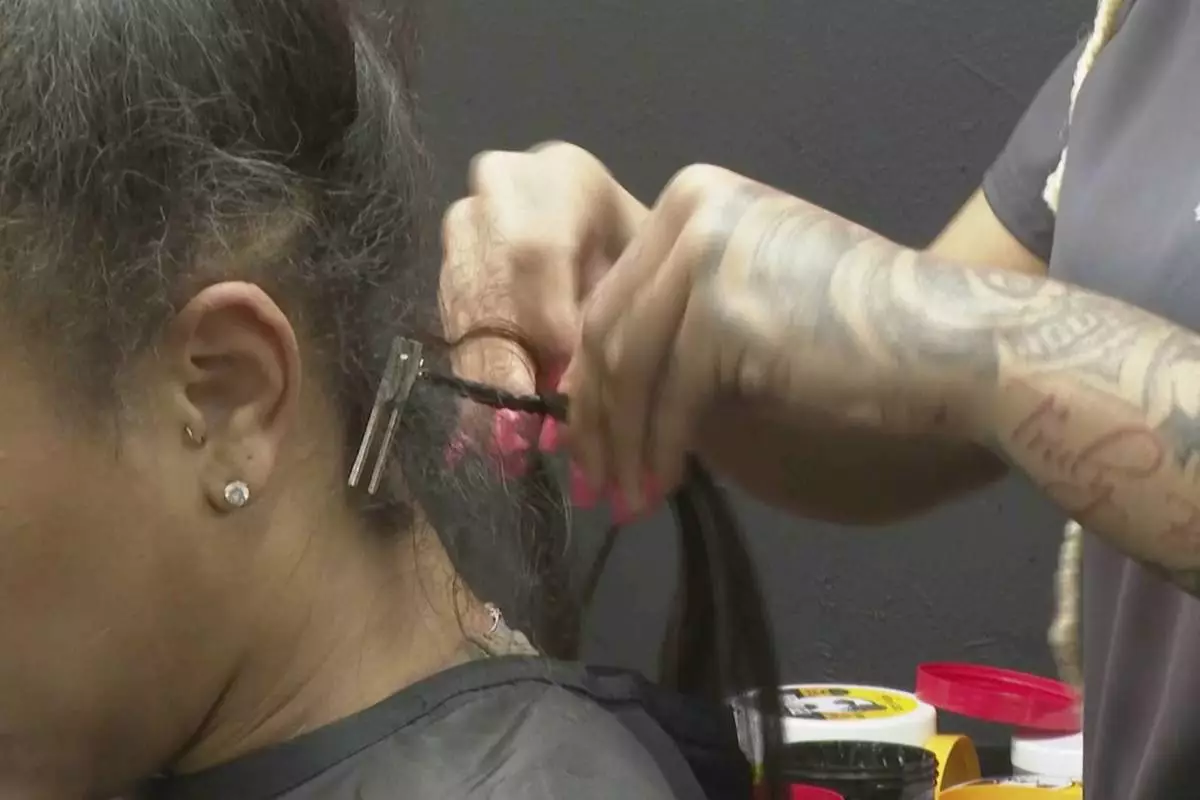
In this image from video, Jahzé Wyse braids a client's hair at her salon in Atlanta on Wednesday, March 19, 2025. (AP Photo/Javier Arciga)

This image from video shows braiding products on a rack at Jahzé Wyse's hair salon in Atlanta on Wednesday, March 19, 2025. (AP Photo/Javier Arciga)

In this image from video, Jahzé Wyse braids a client's hair at her salon in Atlanta on Wednesday, March 19, 2025. (AP Photo/Javier Arciga)
Global markets plunged Monday following last week's two-day meltdown on Wall Street, and U.S. President Donald Trump said he won't back down on his sweeping new tariffs, which have roiled global trade.
Countries are scrambling to figure out how to respond to the tariffs, with China and others retaliating quickly.
Trump’s tariff blitz fulfilled a key campaign promise as he acted without Congress to redraw the rules of the international trading system. It was a move decades in the making for Trump, who has long denounced foreign trade deals as unfair to the U.S.
The higher rates are set to be collected beginning Wednesday, ushering in a new era of economic uncertainty with no clear end in sight.
Here's the latest:
Israeli Prime Minister Benjamin Netanyahu will meet U.S. President Donald Trump in Washington Monday, becoming the first foreign leader to visit since Trump unleashed tariffs on countries around the world.
Whether Netanyahu’s visit succeeds in bringing down or eliminating Israel’s 17% tariff remains to be seen, but how it plays out could set the stage for how other world leaders try to address the new tariffs.
Netanyahu’s office has put the focus of his hastily organized Washington visit on the tariffs, while stressing that the two leaders will discuss major geopolitical issues including the war in Gaza, tensions with Iran, Israel-Turkey ties and the International Criminal Court.
Eytan Gilboa, an expert on U.S.-Israel relations, said he expected Trump to use the tariffs as leverage to force out concessions from Netanyahu. Trump may pressure Netanyahu to move toward ending the war in Gaza, at the very least through some interim truce with Hamas that would pause the fighting and free more hostages.
In a preemptive move last week, Israel announced that it was removing all tariffs on goods from the U.S., mostly on imported food and agricultural products.
Germany’s economy minister says the premise of U.S. President Donald Trump’s wide-ranging tariffs is “nonsense,” and he is arguing that Europe is in a strong position.
Robert Habeck, who is also vice chancellor in Germany’s outgoing government, said as he arrived at a meeting of European Union trade ministers in Luxembourg Monday that he and his colleagues must act “calmly, prudently but also clearly and with determination.”
He said that means “being clear that we are in a strong position — America is in a position of weakness.” He argued that “we don’t have time pressure now,” but the U.S. does.
Habeck said it’s important for the EU to stick together, arguing that attempts by individual countries to win exemptions haven’t worked in the past. He stressed the importance of trade agreements and contacts with other regions of the world, such as South America, Asia and the Pacific.
The German minister said of Trump’s tariffs that “even the basis of the calculation is nonsense: The assumption that a trade budget surplus or deficit is a problem in itself is a wrong estimation.”
Indonesia says it won't retaliate against Trump’s 32% tariff but will pursue diplomacy and negotiations to seek mutually beneficial solutions.
Indonesia, which had an $18 billion trade surplus with the U.S. last year, will gather input from business leaders to create a strategy for addressing the tariffs and find ways to reduce the deficit, Coordinating Economic Affairs Minister Airlangga Hartarto said Monday.
“We will increase the volume of purchases so that the $18 billion trade deficit can be reduced,” Hartarto said.
China on Monday accused the United States of unilateralism, protectionism and economic bullying with tariffs.
“Putting ‘America First’ over international rules is a typical act of unilateralism, protectionism and economic bullying,” Foreign Affairs spokesperson Lin Jian told reporters.
Last week, Trump put an additional 34% tariff on Chinese goods, on top of two rounds of 10% tariffs already declared in February and March, which Trump said was due to Beijing’s role in the fentanyl crisis. China and other governments retaliated quickly. China announced its own 34% tariff rate on U.S. goods.
Lin said the new tariffs harmed the stability of global production and supply chains and seriously impacted the world’s economic recovery.
“Pressure and threats are not the way to deal with China. China will firmly safeguard its legitimate rights and interests,” Lin added.
European shares dropped in early trading, with Germany’s DAX falling 6.5% to 19,311.29. In Paris, the CAC 40 shed 5.7% to 6,861.27, while Britain’s FTSE 100 lost 4.5% to 7,694.00.
South Korea’s top trade negotiator will visit Washington this week to express Seoul’s concerns over the Trump administration’s increased tariffs and discuss ways to mitigate their negative impact on South Korean businesses.
South Korea’s Ministry of Trade, Industry and Energy said Monday that its minister of trade, Inkyo Cheong, plans to meet with various U.S. officials, including U.S. Trade Representative Jamieson Greer.
The ministry says Cheong aims to gather detailed information on the Trump administration’s trade policies and engage in discussions to reduce the 25% tariffs placed on South Korean products.
Chinese government officials met business representatives from Tesla, GE Healthcare and other U.S. companies on Sunday. It called on them to issue “reasonable” statements and take “concrete actions” on addressing the issue of tariffs.
“The United States in recent days has used all sorts of excuses to announce indiscriminate tariffs on all trading partners, including China, severely harming the rules-based multilateral trade system,” said Ling Ji, a vice minister of commerce, at the meeting with 20 U.S. companies.
“China’s countermeasures are not only a way to protect the rights and interests of companies, including American ones, but are also to urge the U.S. to return to the right path of the multilateral trading system," Ling added.
Ling also promised that China would remain open to foreign investment, according to a readout of the meeting from the Ministry of Commerce.
Malaysia’s Trade Minister Zafrul Abdul Aziz said his country wants to forge a united response from Southeast Asia to the sweeping U.S. tariffs.
Malaysia, which is the chair of the Association of Southeast Asian Nations this year, will lead the regional bloc’s special Economic Ministers’ Meeting on April 10 in Kuala Lumpur to discuss the broader implication of the tariff measures on regional trade and investment, Zafrul told a news conference on Monday.
“We are looking at the investment flow, macroeconomic stability and ASEAN's coordinated response to this tariff issue,” Zafrul said.
ASEAN leaders will also meet to discuss member states’ strategies and to mitigate potential disruptions to regional supply chain networks.
Pakistan plans to send a government delegation to Washington this month to discuss how to avoid the 29% tariffs imposed by the U.S. on imports from Pakistan, officials said Monday.
The development came two days after Pakistan’s prime minister asked its finance minister to send him recommendations for resolving the issue. The U.S. imports around $5 billion worth of textiles and other products from Pakistan, which heavily relies on loans from the International Monetary Fund and others.
The Pakistan Stock Exchange fell rapidly on Monday. The exchange suspended trading for an hour after a 5% drop in its main KSE-30 index.
Middle East stock markets tumbled as they struggled with the dual hit of the new U.S. tariffs and a sharp decline in oil prices, squeezing energy-producing nations that rely on those sales to power their economies and government spending.
Benchmark Brent crude is down by nearly 15% over the last five days of trading, with a barrel of oil costing just over $63. That’s down nearly 30% from a year ago, when a barrel cost over $90.
That cost per barrel is far lower than the estimated break-even price for producers. That’s coupled with the new tariffs, which saw the Gulf Cooperation Council states of Bahrain, Kuwait, Oman, Qatar, Saudi Arabia and the United Arab Emirates hit with 10% tariffs. Other Mideast nations face higher tariffs, like Iraq at 39% and Syria at 41%.
The Dubai Financial Market exchange fell 5% as it opened for the week. The Abu Dhabi Securities Exchange fell 4%.
Markets that opened Sunday saw losses as well. Saudi Arabia’s Tadawul stock exchange fell over 6% in trading. The giant of the exchange, Saudi Arabia’s state-owned oil company Aramco, fell over 5% on its own, wiping away billions in market capitalization for the world’s sixth-most-valuable company.
Beijing struck a note of confidence on Monday even as markets in Hong Kong and Shanghai tumbled.
“The sky won’t fall. Faced with the indiscriminate punches of U.S. taxes, we know what we are doing and we have tools at our disposal," wrote The People's Daily, the Communist Party's official mouthpiece.
China announced a slew of countermeasures on Friday evening aimed at Trump’s tariffs, including its own 34% tariffs on all goods from the U.S. set to go in effect on Wednesday.
The Australian dollar fell below 60 U.S. cents on Monday for the first time since the early months of the COVID-19 pandemic.
The drop reflected concerns over the Chinese economy and market expectations for four interest rate cuts in Australia this calendar year, Australian Treasurer Jim Chalmers said.
“What our modeling shows is that we expect there to be big hits to American growth and Chinese growth and a spike in American inflation as well,” Chalmers said.
“We expect more manageable impacts on the Australian economy, but we still do expect Australian GDP to take a hit and we expect there to be an impact on prices here as well,” he added.
The Trump administration assigned Australia the minimum baseline 10% tariff on imports in the the United States. The U.S. has enjoyed a trade surplus with Australia for decades.
Indian stocks fell sharply on Monday, seeing their biggest single-day drop in percentage terms since March 2020 amid the pandemic.
The benchmark BSE Sensex and the Nifty 50 index both dropped about 5% after trading opened but then recovered slightly. Both were later trading down about 4%.
President Donald Trump said Sunday that he won’t back down on his sweeping tariffs on imports from most of the world unless countries even out their trade with the U.S., digging in on his plans to implement the taxes that have sent financial markets reeling, raised fears of a recession and upended the global trading system.
Speaking to reporters aboard Air Force One, Trump said he didn’t want global markets to fall, but also that he wasn’t concerned about the massive sell-off either, adding, “sometimes you have to take medicine to fix something.”
His comments came as global financial markets appeared on track to continue sharp declines once trading resumes Monday, and after Trump’s aides sought to soothe market concerns by saying more than 50 nations had reached out about launching negotiations to lift the tariffs.
“I spoke to a lot of leaders, European, Asian, from all over the world,” Trump said. “They’re dying to make a deal. And I said, we’re not going to have deficits with your country. We’re not going to do that, because to me a deficit is a loss. We’re going to have surpluses or at worst, going to be breaking even.”
Asian markets plunged on Monday following last week’s two-day meltdown on Wall Street, and U.S. President Donald Trump said he won’t back down on his sweeping tariffs on imports from most of the world unless countries even out their trade with the U.S.
Tokyo’s Nikkei 225 index lost nearly 8% shortly after the market opened on Monday. By midday, it was down 6%. Hong Kong’s Hang Seng dropped 9.4%, while the Shanghai Composite index was down 6.2%, and South Korea’s Kospi lost 4.1%.
U.S. futures also signaled further weakness.
Market observers expect investors will face more wild swings in the days and weeks to come, with a short-term resolution to the trade war appearing unlikely.
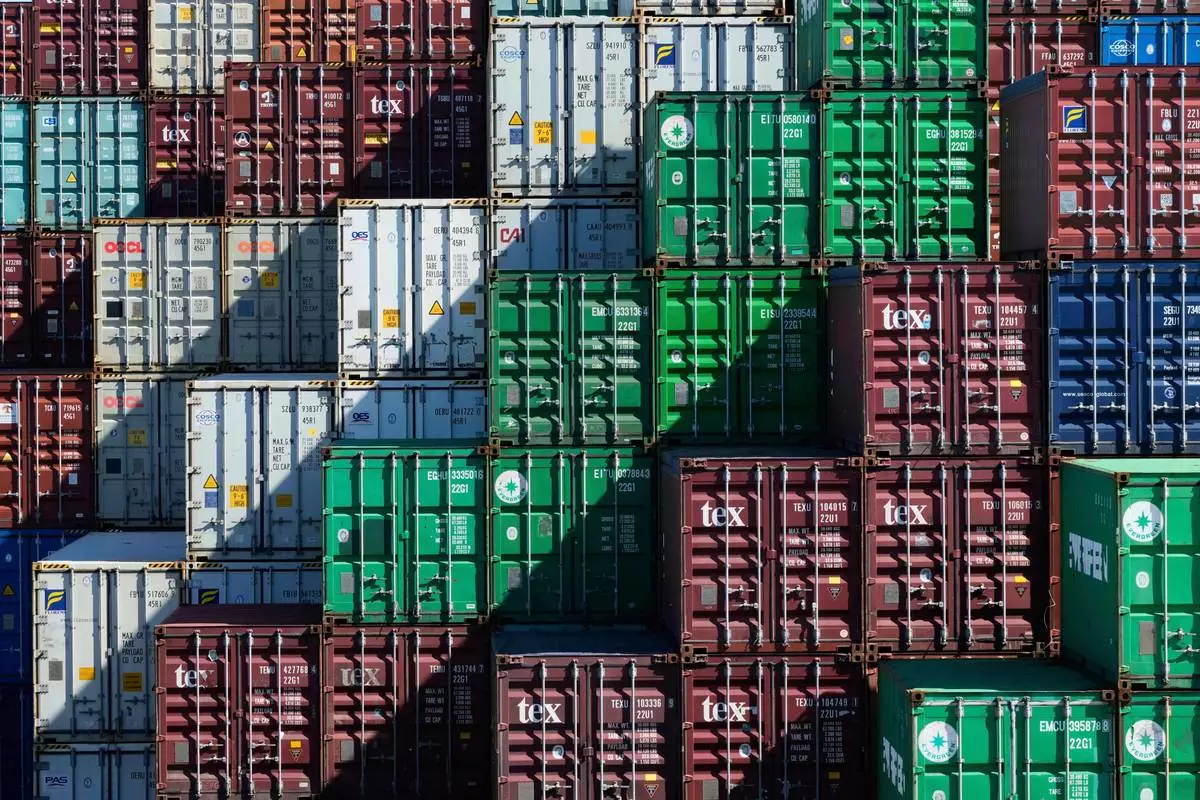
Shipping containers are stacked at Port Botany in Sydney, Australia, Monday, April 7, 2025. (AP Photo/Rick Rycroft)
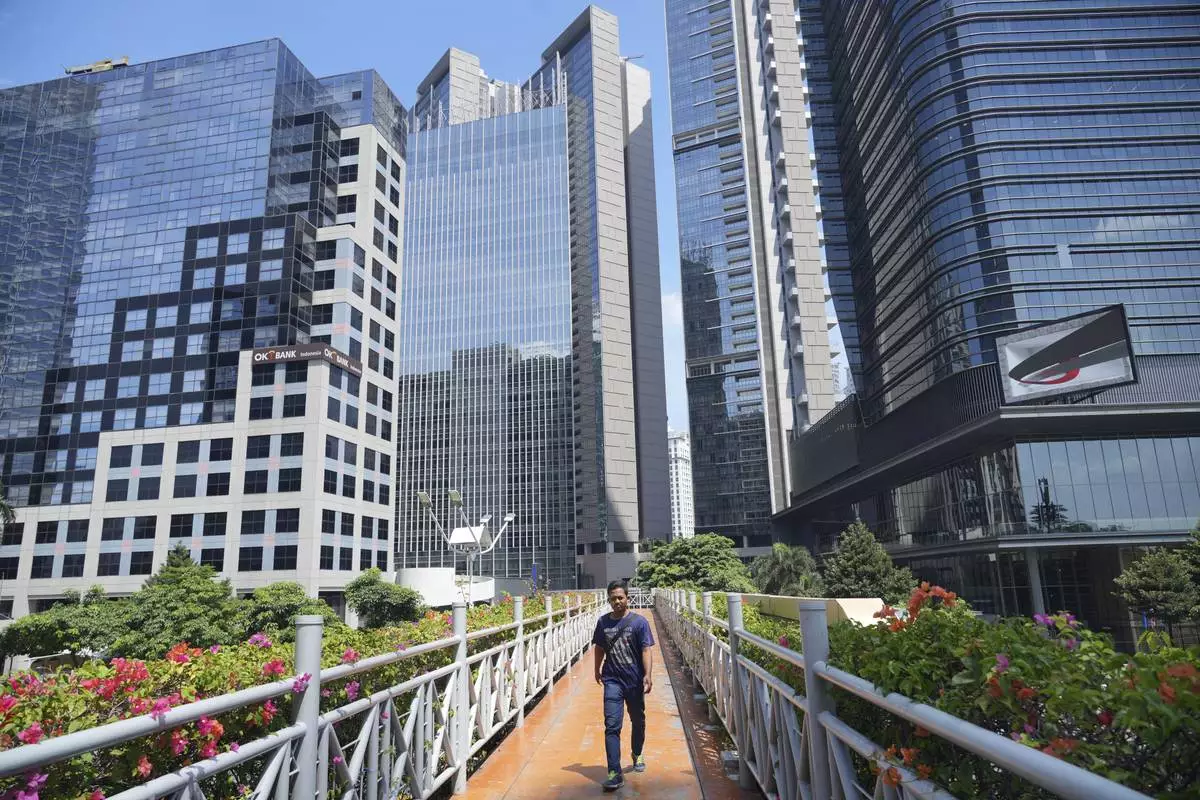
A man walks on a pedestrian bridge as tall buildings are seen in the background at the main business district in Jakarta, Indonesia, Monday, April 7, 2025. (AP Photo/Tatan Syuflana)
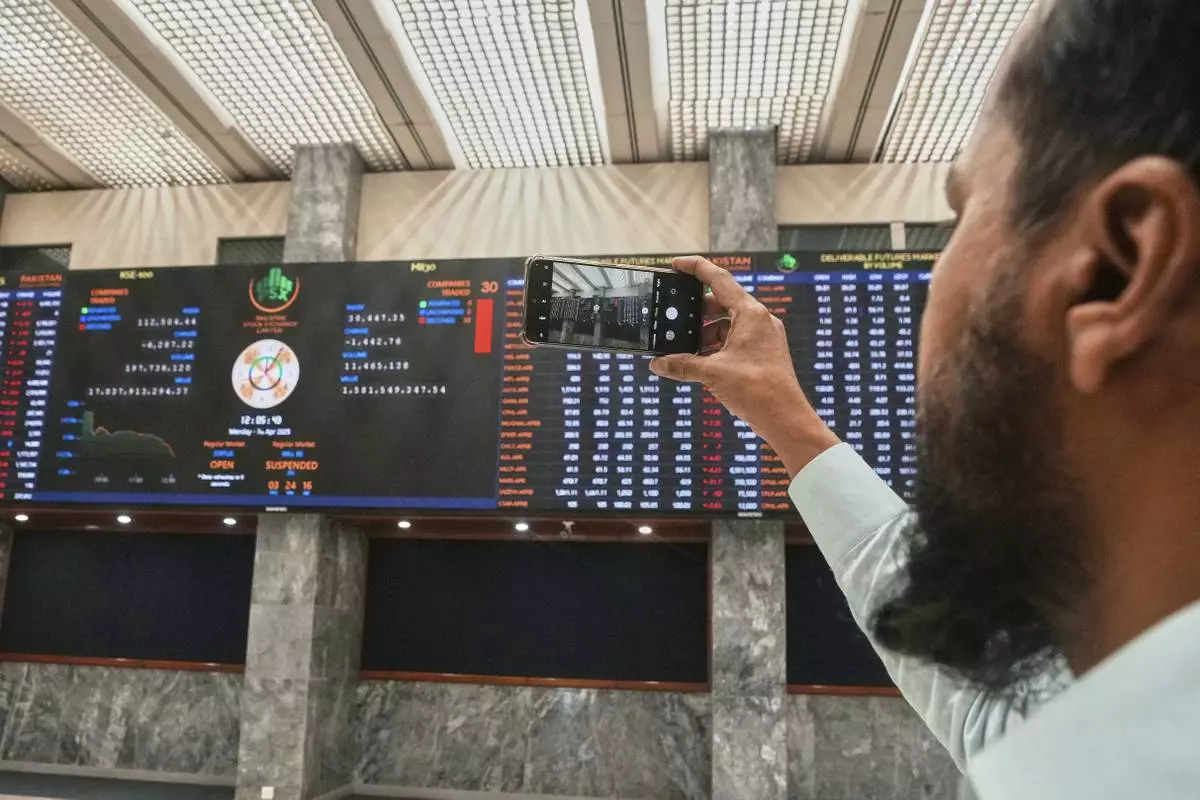
An investor takes a picture with a cell phone of indexes and benchmark 100 index at the Pakistan Stock Exchange (PSE), in Karachi, Pakistan, Monday, April 7, 2025. (AP Photo/Fareed Khan)

Emiratis are seen in the Dubai Financial Market in Dubai, United Arab Emirates, Monday, April 7, 2025. (AP Photos/Fatima Shbair)
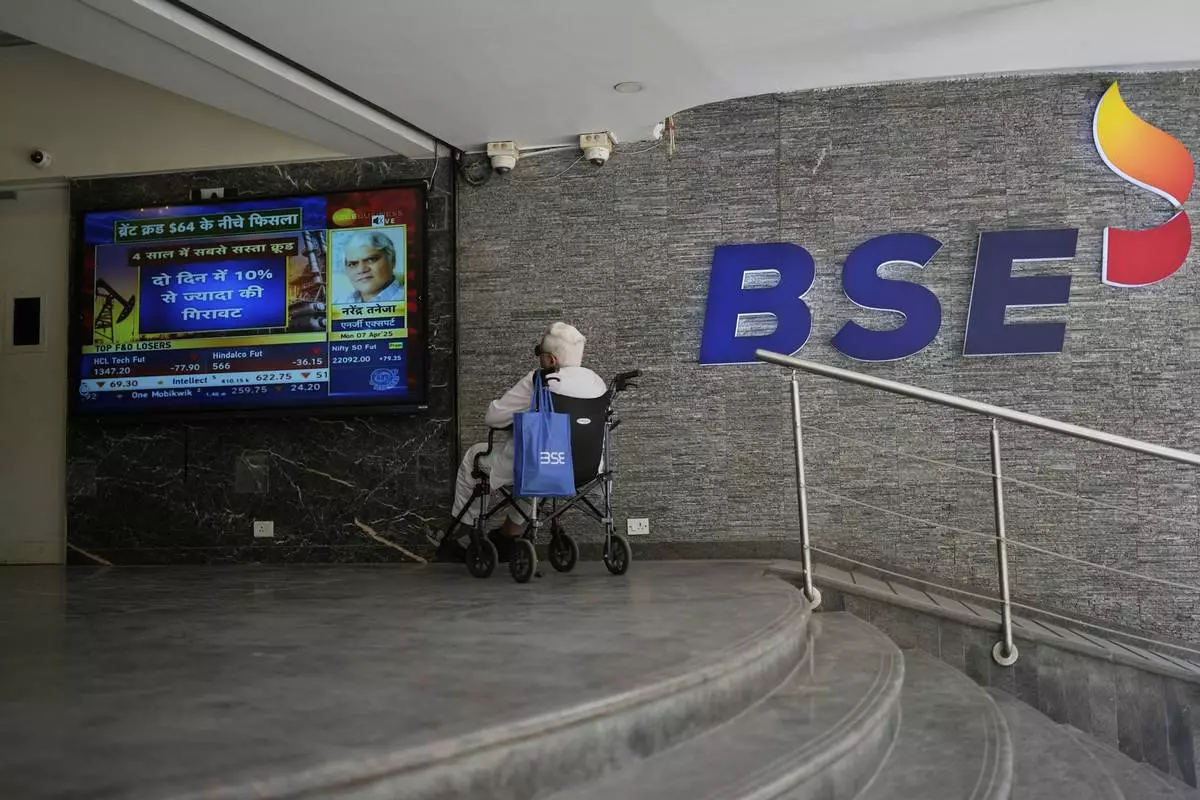
A man sits on a wheelchair and watches a live screen outside Bombay Stock Exchange (BSE) building in Mumbai, India, Monday, April 7, 2025. (AP Photo/Rajanish Kakade)
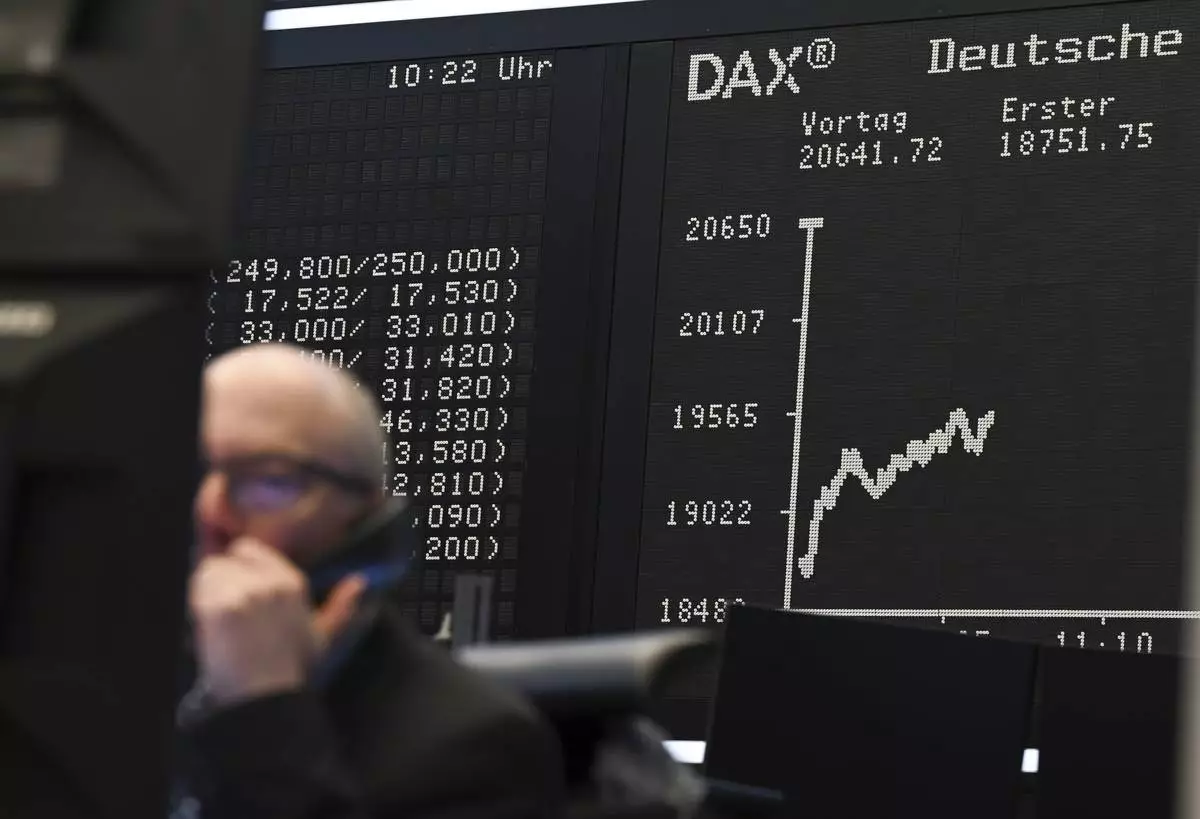
While a stock exchange trader sits in front of his monitors on the trading floor of the Frankfurt Stock Exchange, Germany, the display board with the Dax curve shows a value of less than 20,000 points. (Arne Dedert/dpa via AP)
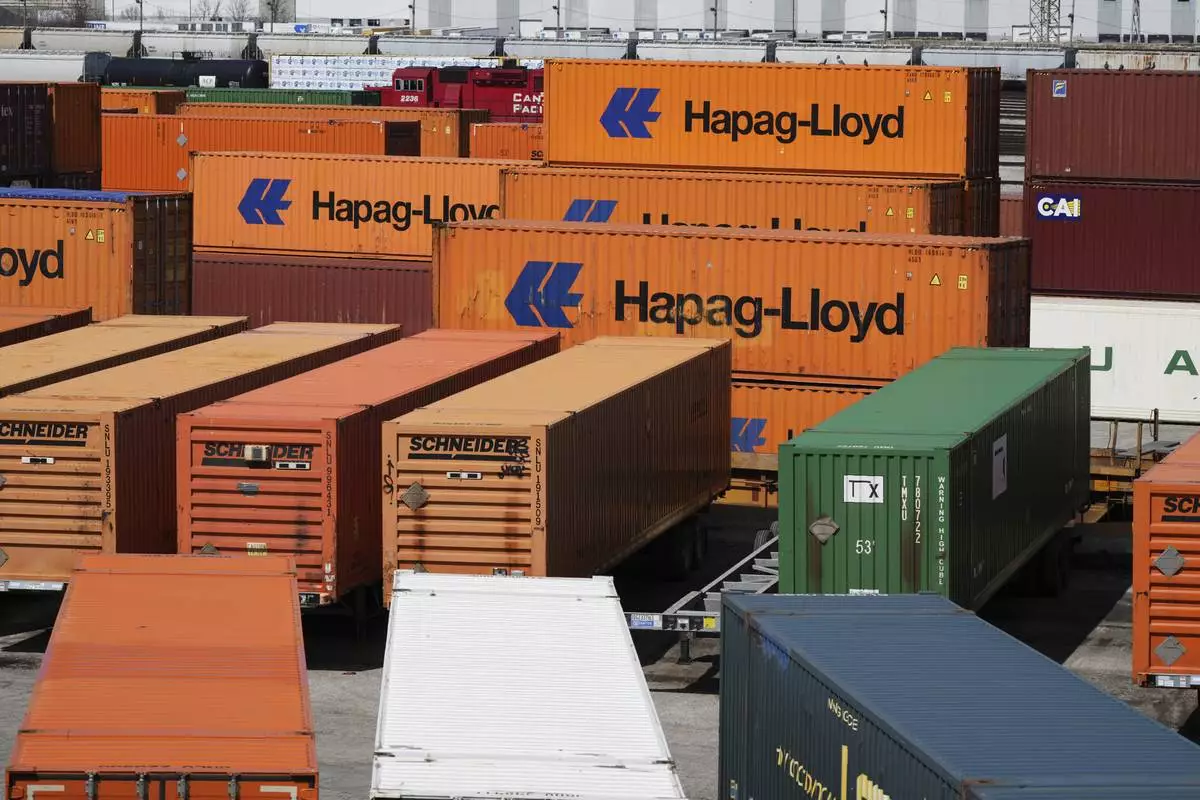
Shipping containers are stored at Bensenville intermodal terminal in Franklin Park, Ill., Sunday, April 6, 2025. (AP Photo/Nam Y. Huh)

Currency traders work near a screen showing the Korea Composite Stock Price Index (KOSPI), top left, and the foreign exchange rate between U.S. dollar and South Korean won, top center, at the foreign exchange dealing room of the KEB Hana Bank headquarters in Seoul, South Korea, Monday, April 7, 2025. (AP Photo/Ahn Young-joon)




















